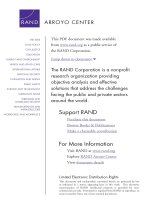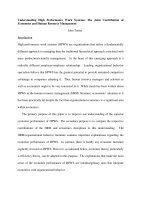Human resource management in growing new ventures core team formation, core team characteristics and core team effects on employment models
Bạn đang xem bản rút gọn của tài liệu. Xem và tải ngay bản đầy đủ của tài liệu tại đây (750.55 KB, 148 trang )
HUMAN RESOURCE MANAGEMENT IN
GROWING NEW VENTURES:
CORE TEAM FORMATION, CORE TEAM CHARACTERISTICS
AND CORE TEAM EFFECTS ON EMPLOYMENT MODELS
AEGEAN LEUNG OI KAM
(MA, MSc)
A THESIS SUBMITTED
FOR THE DEGREE OF DOCTOR OF PHILOSOPHY
DEPARTMENT OF MANAGEMENT AND ORGANIZATION
NATIONAL UNIVERSITY OF SINGAPORE
1
Acknowledgements
After years of working in the industry, I decided to go back to school to pursue my doc-
torate degree in a topic I have come to regard as one of the most important elements for the
success of growing new ventures – human resource management during the early years of
those firms. During the years of the doctorate course, thanks to the faith and support of my
supervisors/advisors in the NUS Business School, and the encouragement from various faculty
members and friends, I have been able to stay on that set course and devote my research efforts
to studying a phenomenon I am passionate about. I am also grateful for the tangible (in the
forms of scholarships and fellowships, etc.) and intangible (in terms of training and recogni-
tion) support provided by the University, the Business School and the Department of Manage-
ment and Organization during my years in the program.
Especially, I would like to express my sincere thanks to my two supervisors, Dr.
Ronald Rodgers (my initial supervisor) and Dr. Foo Maw Der (my current supervisor) for their
invaluable guidance and inputs during the whole process of my doctorate course, from the de-
velopment of the research proposal to the implementation of data collection, to the final or-
ganization and writing of the thesis. I would also like to thank Dr. Wong Poh Kam and Dr.
Daniel McAllister, who were kind enough to be my thesis committee members, and who have
allowed me to leverage on their networks and domain expertise for my research pursuits. My
thanks also go to Dr Rao Kowtha, who is always there to offer advice, in and outside of his ca-
pacity as the director of the PhD program, and my fellow PhD student, Mr. Sankalp
Chaturvedi, who is always there for me whenever I need some advice concerning statistical
procedures, and Mrs. Mavis McAllister for carefully reading through several chapters of my
manuscript.
Last but not least, I must state that I could not have gone through the PhD program with
such speed and focus without my very loving, supportive and understanding husband, Dr. Fre-
derick H. Willeboordse. My children, Alpha, Beta and Gamma deserve their share of credits in
putting up with a rather absent-minded mom who on occasions got all absorbed into her re-
search problems and forgot some of the finer details of day to day life.
2
Table of Contents
ACKNOWLEDGEMENTS 2
TABLE OF CONTENTS 3
SUMMARY 5
LIST OF TABLES 7
LIST OF FIGURES AND CHARTS 8
CHAPTER 1: INTRODUCTION 9
CHAPTER 2: DIFFERENT TIES FOR DIFFERENT NEEDS - THE USE OF NETWORKS IN CORE
TEAM RECRUITMENT IN NEW VENTURES 17
2.1 INTRODUCTION 17
2.2 A SYSTEM APPROACH OF FIT 19
2.3 MULTIPLE CONSIDERATIONS OF FIT IN CORE TEAM RECRUITMENT 20
2.3.1 Organizational Constraints and Core Team Recruitment 20
2.3.2 Strategic Consideration in Team Member Selection 22
2.3.3 P-O Fit Considerations in Team Member Selection 23
2.4 DIFFERENT TIES FOR DIFFERENT NEEDS 24
2.4.1 Network Recruitment as the Dominant Practice in Team Member Acquisition 24
2.4.2 From Social Ties to Business Ties 26
2.4.3 The Persistence of Strong Ties 27
2.5 METHODS 28
2.5.1 Samples and Data Collection 28
2.5.2 Measures of Key Concepts and Data Analysis 30
2.6 FINDINGS AND INTERPRETATIONS 32
2.7 DISCUSSION 38
2.7.1 Implications of the Current Study 38
2.7.2 Limitations and Future Research 41
CHAPTER 3: OWNERSHIP IMPRINTING ON NEW VENTURE TEAM FORMATION AND
COMPOSITION 43
3.1 INTRODUCTION 43
3.2 CURRENT LITERATURE ON NEW VENTURE TEAM FORMATION AND COMPOSITION 46
3.3 OWNERSHIP STRUCTURE AND NEW VENTURE TEAMS 47
3.3.1 Founding ownership structure and the use of networks in recruiting the startup team 49
3.3.2 Founding ownership structure and diversity of startup teams 52
3.3.3 Imprinting of founding ownership structure on growth teams 54
3.4 METHODS 56
3.4.1 Sample and Data Collection 56
3.4.2 Measures of Key Variables and Data Analysis 57
3.5 ANALYSIS AND RESULTS 59
3.5.1 Networks versus market recruitment 59
3.5.2 Ownership structure and new venture team composition 59
Descriptive statistics 59
3.6 DISCUSSION 63
3.6.1 Founding ownership structure and the use of networks in recruiting core team members. 64
3.6.2 Founding ownership structure and functional diversity of the core team 65
3.6.3 Limitations and implications of this study 66
CHAPTER 4: CHANGE AND STABILITY OF EMPLOYMENT MODELS IN GROWING NEW
VENTURES: A SIMULTANEOUS EXAMINATION OF CORE TEAM IMPRINTING, STRUCTURAL
INERTIA, AND ADAPTIVE PRESSURES 69
4.1 INTRODUCTION 69
4.2 EMPLOYMENT MODEL AND ITS CHANGE AND STABILITY 73
3
4.2.1 Typologies of Employment Models Based on Core Values 73
4.2.2 Typologies of Employment Models Based on HR Practices 75
4.2.3 Change and Stability of Employment Models 78
4.3 IMPRINTING EFFECTS AND ADAPTIVE PRESSURES ON EMPLOYMENT MODELS 79
4.3.1 The Imprinting Mechanism 79
4.3.2 The Intervening Effects of Adaptive Pressures 89
4.4 METHODS 92
4.4.1 Sample and Data Collection 92
4.4.2 Measures of Key Variables 94
4.5 DATA ANALYSIS AND RESULTS 99
4.5.1 Descriptive Statistics 99
4.5.2 Imprinting Effects of New Venture Core Team on the Startup Employment Model 101
4.5.3 Structural Imprinting of the Initial Employment Model 102
4.5.4 The Moderating Effects of Core Team Change 102
4.5.5 The Moderating Effects of Adaptive Pressures 104
4.6 DISCUSSION 106
CHAPTER 5: DISCUSSION AND FUTURE RESEARCH DIRECTION 113
5.1 RESEARCH FINDINGS 114
5.2 THEORETICAL CONTRIBUTIONS OF THIS RESEARCH 117
5.3 PRACTICAL IMPLICATIONS OF THIS RESEARCH 120
5.4 LIMITATIONS AND FUTURE RESEARCH DIRECTIONS 122
REFERENCES 125
APPENDICES 141
4
SUMMARY
New ventures face significant challenges in attracting and acquiring critical human re-
sources, as well as in building a coherent human resource management system that not only
binds people together during the startup phase when the firm is struggling for survival, but also
caters to changing human resource needs when the firm has transited to the growth phase. Our
knowledge on how growing new ventures manage their human resource challenges is still very
limited. Existing research on human resource management has been based largely on the con-
text of established firms. Human resource practices in large organizations, however, do not
automatically apply to young and small entrepreneurial firms with fewer resources at their dis-
posal, which are at the same time facing a volatile operating environment Hence, there is a
need to study human resource challenges and practices of growing new ventures in their unique
context.
This research attempts to capture unique human resource management phenomena in
new ventures, specifically on how core team members are acquired during the startup and the
growth phases, and some of the internal and external contexts that may affect the choice of
team members. It also explores the change paths of the employment model in new ventures
from their startup to their growth phases, taking into account influences from the core team, the
initial model design, and the external pressures for change.
Findings from this research suggest that entrepreneurs tend to leverage personal net-
work ties (in both social and business circles) at the startup phase in recruiting core team mem-
bers. The extent to which entrepreneurs can continue to rely on their direct network ties to ac-
quire core team members during their growth phase, however, varies with their personal en-
dowment in network range and reach, which may be influenced by factors such as industrial
experience. The business partnerships built through the initial years of the firm, moreover,
5
may also lead to the increased use of business ties and indirect ties in acquiring core human
resources. Furthermore, team members can be chosen based more on affective considerations
of similarity-attraction, or on instrumental concerns of strategic fit, depending on different
types of ownership influence (the presence or absence of institutional ownership at founding as
examined in this research). The different decision criteria can in turn lead to teams with differ-
ent levels of diversity. Meanwhile, the characteristics of the core team can also exert an influ-
ence on the design and evolution of the employment model in new ventures. Startup teams
with shared organizational experience tend to be able to design more coherent initial employ-
ment models. The coherence level of the initial employment model in turn relates to the coher-
ence of the employment model of the firm at the growth phase, but is subject to the impact
from changes in core team membership, and pressures from the institutional and competitive
environment.
An understanding of the phenomena of people management in new ventures is the first
step in formulating effective HRM strategies for those firms to survive their startup phase, and
effectively transit to their growth phase. This research contributes to knowledge building with
regard to human resource challenges and practices in relatively young and small firms. The
theoretical models used in the studies can also serve as the basis for future research in conduct-
ing more rigorous tests of the relationships among the key variables identified, advancing and
synthesizing research in the field of human resource management in the specific context of
young and growing entrepreneurial firms.
6
List of Tables
Table 2.1 Growth phases and recruitment channels by position 35
Table 2.2 Growth phases and types of networks used in hiring 36
Table 2.3 Growth phases and strength of ties used in hiring 37
Table 3.1 Founding ownership structure and recruitment channels 60
Table 3.2 Correlations matrix 60
Table 3.3 Founding ownership structure and startup team composi-
tion
61
Table 3.4 Founding ownership structure and growth team composi-
tion
62
Table 3.5 Regression results on the mediating role of startup team
composition
63
Table 4.1 Means, standard deviations, and correlations of key vari-
ables
100
Table 4.2 Regression results on effects of startup team on coherence
of initial employment model
101
Table 4.3 Regression results of effects of startup model coherence on
growth model coherence
102
Table 4.4 Moderating effects of change in team membership 103
Table 4.5 Moderating effects of adaptive pressures 105
7
List of Figures and Charts
Figure 1.1 Scope of research covered in this thesis 11
Figure 2.1 Multiple fit considerations in core team recruitment 20
Figure 3.1 Ownership imprinting on new venture core teams 45
Figure 4.1 Change and stability of employment models from startup
to growth
72
Figure 4.2 Different types of employment models 77
Chart 4.1 Hypothesized interaction effects between shared organiza-
tional experience and functional diversity
85
Chart 4.2 Moderating effects of change in team membership 104
Chart 4.3 Moderating effects of coercive pressures 105
Chart 4.4 Moderating effects of normative pressures 106
Chart 4.5 Moderating effects of environmental dynamism 106
8
Chapter 1:
Introduction
How people are managed can drive companies to success or failure (O'Reilly and
Pfeffer, 2000). This is especially true for new ventures with organizational foundations that
are still fragile. Entrepreneurs unable or unwilling to deal effectively with HRM-related is-
sues find it difficult to attract and retain top employees, and motivate those who remain.
These entrepreneurs will in general not be able to realize their business vision and create
value with their business ideas (Baron, 2003; Katz and Welbourne, 2002). On the other hand,
the maximization of the value of human resources through proper management can provide a
competitive advantage for the firm (Barney and Wright, 1998).
While there is abundant literature studying human resource management in large, es-
tablished organizations, relatively little research has covered human resource challenges in
young, small and growing new ventures (Baron, 2003; Cardon and Stevens, 2004; Tansky
and Heneman, 2003). Human resource management theories and practices applicable to
large, established firms may not necessarily fit the context of young and small firms (Hene-
man and Tansky, 2002). The different concerns and challenges faced by younger and smaller
firms, such as ‘the liability of newness and smallness’ amplified by the lack of resources and
legitimacy, and a high level of uncertainty, lead to the adaptation of different practices in
human resource acquisition and management (Barber, Wesson, Robertson and Taylor, 1999;
Heneman and Berkley, 1999; Ram, 1999). In recent years, repeated calls have been made for
more research to develop deeper insights into the phenomenon of human resource manage-
ment in relatively young and small entrepreneurial firms by developing additional observa-
9
tions, taxonomies, and theories (Baron, 2003; Katz and Welbourne, 2002; Tansky and Hene-
man, 2003).
Traditionally, studies on human resources in new ventures focus on the persona of the
founder (see for example, Boeker, 1988, and Schein, 1983). A growing amount of literature
in recent years, however, challenges the position that the entrepreneur is the lone hero in the
entrepreneurial process (Boeker and Wiltbank, 2005; Cooney, 2005; Eisenhardt and Schoon-
haven, 1990; Forbes Borchert, Bruhn and Sapienza, 2006; Kor, 2003). The venture creation
process usually begins with a lead entrepreneur with an idea for a new enterprise. He or she
then approaches people who may buy into the idea to build the enterprise together. It is the
characteristic of such a core team, rather than that of the single entrepreneur, that influences
venture performance and success (Eisenhardt and Schoonhaven, 1990; Ensley and Pearce, 2001;
Hambrick and Crozier, 1985).
Hence, an initial step in understanding human resource manage-
ment in new ventures can start with an examination of how new ventures put together their
core teams.
In this thesis I focus on examining how entrepreneurs put their initial core human re-
sources (new venture core teams) together (Chapter 2), contextual factors that influence the
characteristics of that core team (Chapter 3), and how the characteristics of the startup core
team imprint themselves on the change and stability of the employment model adopted by
new ventures (Chapter 4). Figure 1 summarizes my research scope.
10
Figure 1.1: Scope of research covered in this thesis
Team
Formation
Team
Characteristics
Team
Effects
Chapter 2
Different ties for different
needs: The use of networks
in human resource acquisi-
tion in growing new ventures
Chapter 4
Change and stability of employment
models in growing new ventures:
A simultaneous examination of core
team imprinting, structural inertia and
adaptive pressures
Chapter 3
Ownership imprinting on new
venture team formation and
composition
In chapter 2, “Different ties for different needs: The use of networks in human re-
source acquisition in growing new ventures”, I argue and find support for the proposition that
due to multiple considerations of organizational constraints, strategic needs, and value fit,
entrepreneurs may rely mainly on informal recruitment channels such as networks in acquir-
ing their core team members during the early phases of the new venture. Moreover, new ven-
tures emerging from their startup to their growth phase may use different network pools in
their search for core team members with different competency fix. To reach for a larger pool
of potential candidates with diverse background and competencies, entrepreneurs may shift
from using their personal social ties to the business network ties of the firm as new ventures
transit from the startup to the growth phase. The preference for strong ties, however, can per-
sist through both phases. My research findings suggest that this can be attributed to the em-
phasis on the “fit” and “trust” elements in the selection of core team members by entrepre-
neurs. The identification of such “softer” elements requires fine-grained information trans-
ferred through a prolonged period of interactions, which are much better transmitted through
strong and direct ties than via weak ties.
To further examine how different organizational context can influence new venture
team compositions, Chapter 3, “Ownership imprinting on new venture core teams formation
and composition”, consists of a study I conducted to examine the effects of founding owner-
11
ship structure on core team recruitment and core team characteristics from the startup to the
early growth phase of the firm. My key argument is that the presence or absence of institu-
tional ownership at founding may lead to the use of different recruitment channels in acquir-
ing team members, and the formation of teams with different characteristics in new ventures.
Such imprinting effects can persist to the growth phase of the firm due to forces of structural
inertia, making the growth team a close resemblance of the startup team. My findings gener-
ally support the proposition of ownership imprinting: While new ventures I studied generally
relied on networks in recruiting their core team members, the presence of institutional owner-
ship at founding led to more functionally diverse teams at the startup as well as the growth
phases. The proportion of indirect hires at the growth phase was also positively related to the
presence of institutional ownership at founding.
Chapter 4, “Change and stability of employment models in growing new ventures: A
simultaneous examination of core team imprinting, structural inertia and adaptive pressures”,
proposes and tests a theoretical model which traces the influence of new venture core teams
on the change and stability of employment models during the startup and growth phases of
the firm, using imprinting effects as the key theoretical lens. My conceptual model, and some
preliminary findings based on a relatively small sample size suggest that the initial design of
a new venture’s employment model reflects the prior organizational experience shared by the
members of the startup core team. The level of shared cognition among team members based
on their shared organizational experience before the formation of the new venture contributes
to the clarity and internal consistency of the initial set of core values relating to the startup
employment model. Once the initial design has been put in place, structural inertia kicks in,
making the characteristics of the employment model during the growth phase a prediction of
the initial design. Such imprinting effects, however, are subject to pressures of adaptation
from the external environment. Changes in the competitive environment, as well as isomor-
12
phic pressures from the institutional environment, can cause changes in the employment
model deviating from the prediction of structural imprinting. Hence change and stability of
employment models in growing new ventures should be understood amidst an intricate bal-
ance between imprinting effects and adaptive pressures.
In the concluding chapter (Chapter 5) I wrap up the thesis by summarizing the overall
research findings from the various papers, and highlight possible directions for future re-
search.
The research scope of this thesis echoes recent calls for an extended model of the up-
per echelon perspective by examining antecedents and effects of top management team com-
positions (Boone, Olffen, Witteloostuijn and Brabander, 2004; Carpenter, Geletkanycz and Sand-
ers, 2004), in the specific context of growing new ventures. Extant research on top manage-
ment teams (TMT) focuses mainly on large, established firms, and in examining the effects of
TMT characteristics on firm strategies and performance (see recent review by Carpenter, et
al., 2004). Given the importance of team characteristics to organizational outcomes, under-
standing the antecedents shaping such characteristics should be an important research agenda
(Boon, et al., 2004; Keck and Tushman, 1993; Pettigrew, 1992). In the context of relatively
young, small and growth oriented ventures, an understanding of the internal and external con-
texts influencing how team members are recruited, as well as the factors that shape team
characteristics, are particularly important. This is because the initial characteristics of the
team not only have significant influence on new venture survival and growth (Eisenhardt and
Schoonhaven, 1990), but also imprint on the initial design of important organizational fea-
tures, and their subsequent evolution (Boeker, 1989, 1997b; Beckman and Burton, 2005).
Research on what shapes new venture core teams, however, is still limited, although it has
grown in recent years (see Boeker and Wiltbank, 2005; Forbes et al., 2006; Ruef, Aldrich and
13
Carter, 2003). My research enriches and extends current literature on how new venture teams
become what they are.
While it is important to understand how top management teams contribute to firm
strategies and financial performance, the team effects on the design and evolution of core or-
ganizational structures, such as the employment model, warrant no less attention. The em-
ployment model represents a core feature of the firm which defines “the basis of exchange
between members and the organization” (Hannan, Burton and Baron, 1996; Hannan and
Freeman, 1984). The way people are selected, trained and rewarded has a strong bearing on
both organizational and individual outcomes. A coherent employment model is particularly
important for new ventures that face a relatively high degree of uncertainty and changing or-
ganizational dynamics because it can ease some of the “growing pains” by providing a frame
of reference for organizational priorities, steering employees towards the common goals. It
also helps to provide some order in a very dynamic context by setting clear parameters for
efforts and rewards. Understanding the key driving forces that shape the change and stability
of employment models in growing new ventures is therefore an important research agenda.
My research examining how core team characteristics influence the design, change and sta-
bility of employment models in growing new ventures represents an initial attempt to imple-
ment such a research agenda.
Scholars conducting research in human resource management in entrepreneurial firms
have pointed out that “at a time of unparalleled technological development, it is human re-
sources that paradoxically spell success or failure for all firms, and especially entrepreneurial
ones” (Katz, Aldrich, Welbourne, and Williams, 2000, p. 7). Brilliant business visions and
opportunities cannot materialize without having the right people in place to execute and im-
plement them. Continuous innovations will not be possible without the right organizational
incentives encouraging creativity and risk taking by organizational members. The studies in
14
my thesis contribute to the important but relatively under-researched area of human resource
management in growing entrepreneurial firms. I hope my research effort, in capturing and
explaining some specific aspects of human resource management in growing new ventures
using multiple theoretical perspectives, will help bridge extant organizational theories to the
study of entrepreneurship. At the same time, it is hoped that the results will provide insights
that can be of reference value for current and future entrepreneurs in meeting human resource
challenges as they attempt to grow their ventures.
15
16
Chapter 2:
Different Ties for Different Needs - The Use of Networks in Core
Team Recruitment in New Ventures
2.1 Introduction
Human resources are critical for firm survival and growth (Heneman and Tansky,
2002; Katz, Aldrich, Welbourne and Williams, 2000). Understanding how organizations can
acquire the right type of talent is therefore of prominent interest to organizational scholars
and practitioners alike, which is why the notion of “fit” is a dominant theme in the human
resource literature (Schneider, 2001). Two streams of HRM literature focus particularly on
the issues of fit, from a macro and a micro perspective, respectively. Strategic human re-
source management (SHRM) literature focuses on how human resource practices can “fit”
organizational strategies in generating the necessary human capital pool to sustain superior
performance (Barney and Wright, 1998; Wright and McMahan, 1992; Wright, Dunford and
Snell, 2001). Person-environment (P-E) fit (or P-O fit when applied to organizations) re-
search, on the other hand, argues that organizational behavior and effectiveness are ultimately
a joint function of characteristics of the organizational environment and the individual (Kris-
tof, 1996; Schneider, Smith and Paul, 2001). While each stream of literature has made sub-
stantial contributions to our understanding of human resource management, research which
simultaneously considers both types of fit has been rare (Werbel and Demarie, 2001). Fur-
thermore, new ventures face unique challenges in human resource management, due to organ-
izational constraints associated with liabilities of newness and smallness (Cardon and Ste-
vens, 2004; Williamson, 2000; Williamson et al., 2002). Hence, over and above the consid-
eration of strategic fit and P-O fit, new ventures may also need to take into account their or-
ganizational constraints when deriving strategies in reaching out for the right pool of talent.
17
Capturing the recruitment practices of a group of relatively young and small entrepreneurial
firms in Singapore from their startup to their growth phase, this paper attempts to illustrate
how the multiple considerations of organizational constraints, strategic fit and P-O fit are re-
flected in the use of networks in recruiting core team members in those firms, and the particu-
lar type of ties entrepreneurs rely on to reach out for different pools of talent as firms transit
from startup to growth.
I focus on the recruitment of core team members in this study because an increasing
number of studies have attributed new venture performance to the characteristics of their new
venture core teams (Boeker and Wiltbank, 2005; Eisenhardt and Schoonhaven, 1990; Ensley
and Pearce, 2001; Kor, 2003). I use the term core team rather than top management team
(TMT) because people with lesser titles may play important strategic roles in entrepreneurial
firms with relatively simple organizational structure,. Core team members thus include indi-
viduals reporting directly to the top executive of a firm, and have a significant impact on the
strategies and practices of the organization despite their titles.
While this is an exploratory study relying on a combination of qualitative and quanti-
tative data based on a small sample of 20 firms, the proposed theoretical framework based on
the “system approach” of contingency theory, taking into account organizational constraints,
strategic needs and person-organization fit provides a useful tool for future research on hu-
man resource practices in growing new ventures. The holistic approach also contributes to
widening the scope of fit considerations in current main stream HRM literature, bridging the
macro and the micro perspectives.
18
2.2 A System Approach of Fit
Underlying the contingency approach is the proposition that performance is a conse-
quence of the “fit”, or congruence, between several factors: structure, people, technology,
strategy, and culture (Nightingale and Toulouse, 1977; Tosi and Slocum, 1984; Van de Ven
and Drazin, 1985). The traditional contingency approach applied in strategic management,
organizational theory and organizational behavior studies, however, rarely goes beyond ex-
amining the “fit” of two contingencies on a performance outcome (Miller, 1981). The “sys-
tem approach” of contingency theory, on the other hand, stresses the need to take into ac-
count the interconnectedness of various factors, and is arguably a more realistic representa-
tion of organizational reality (Drazin and Van de Ven, 1985; Miller, 1981). Under the “sys-
tem approach”, fit is defined as “the internal consistency of multiple contingencies and multi-
ple structural characteristics” (Drazin and Van de Ven, 1985, pg. 515). Such an approach
advocates the simultaneous consideration of the interaction among environmental, strategic
and people variables within a certain structure (Miller, 1981; Van de Ven and Drazin, 1985;
Venkatraman and Prescott, 1990).
Adapting such a “system approach” in this study, I propose a multi-dimensional,
multi- contingency model of “fit” to examine why network recruitment becomes the most
commonly adapted practice among entrepreneurial firms in acquiring their core team mem-
bers. I further posit that the network ties utilized may vary with changing organizational con-
text represented by two different developmental phases of the firms. Figure 2.1 summarizes
my conceptual framework for this paper. The model suggests that multiple considerations of
organizational constraints, strategic needs and values fit all play a part in influencing the hir-
ing practices for core members in entrepreneurial firms. The contingencies in these multiple
dimensions, moreover, change as firms evolve from their startup to their growth phase. In
this study, the startup phase is defined as the inception and survival stages of the firm, and the
19
transition to the growth phase is signified by the emergence of a clear growth strategy, fol-
lowed by consecutive years of rapid growth (Churchill and Lewis, 1983; Hanks, Watson,
Jansen and Chandler, 1993; Hite and Hesterley, 2001). In the following sections, I will build
up the specific hypotheses and provide empirical evidence on how the multiple considera-
tions of organizational constraints, strategic needs and P-O fit at the startup and the growth
phase of the firm relate to the use of networks in recruiting core team members.
Figure 2.1. Multiple fit considerations in core team recruitment
Liability of newness and smallness
•High uncertainty
•Lack of organizational legitimacy
•Lack of various resources
Organizational
constraints
Strong ties from
personal social
networks
Strong ties from
business
networks
Network
Utilization
Start-up phase Growth phase
Multi-dimensional contingents
P-O Fit
consideration
Shared personal
aspirations
Shared business
visions
Strategic
needs
Background
similarity
Recruitment
practices
Functional
diversity
2.3 Multiple Considerations of Fit in Core Team Recruitment
2.3.1 Organizational Constraints and Core Team Recruitment
Defined as young, small, and growing (Baker and Aldrich, 2000; Markman and
Baron, 2002), entrepreneurial firms in general are saddled with the “liability of newness and
smallness” (Aldrich and Auster, 1986; Ranger-Moore, 1997; Stinchcombe, 1965). They may
not have the abundant resources at their disposal as large, established firms would have. The
20
organizational practices they adapt are more often than not the result of “improvisation”
(Baker and Aldrich, 2000) and “effectuation” (Sarasvathy, 2001). Instead of having the
choice of various means to achieve a specific goal, entrepreneurial firms usually have to
“make do” with the limited resources they have in hand to attain the best outcomes they can
get.
Similarly, liabilities of newness and smallness are generally quoted as the constrain-
ing factors for firms to compete in the talent market (Cardon and Stevens, 2004; Williamson,
2000; Williamson et al., 2002). Such liabilities are manifested in the lack of financial and ma-
terial resources (Hannan and Freeman, 1984), the lack of organizational legitimacy (William-
son, 2000) and a high level of uncertainty (Gartner, Bird and Starr, 1992). The lack of finan-
cial resources may hamper entrepreneurial firms’ ability to offer attractive remuneration
packages. Resource constraints also cause them to shy away from investment intensive
methods such as college recruitment (Barber, Wesson, Robertson and Taylor, 1999). Unlike
larger, well-known firms, entrepreneurial firms often cannot rely on their name, their reputa-
tion in the industry, or their market share to attract talent (Aldrich, 1999). The HR function is
also usually underdeveloped in smaller firms. In addition to their other roles, owners or line
management have to recruit staff and they are less likely to employ sophisticated recruitment
and selection programs (Barber et al., 1999; Heneman and Berkley, 1999). The deviation
from institutionalized recruitment practices, together with the general absence of well-defined
job descriptions for positions, reduces entrepreneurial firms’ legitimacy as employers-of-
choice (Williamson, 2000). From the potential recruit’s perspective, committing one’s career
to a relatively young and small firm can be a high-risk undertaking due to the relatively high
mortality rate of firms at their early and adolescence stages (Bruderl and Schussler, 1990;
Hannan and Freeman, 1989). I therefore propose:
21
Hypothesis 1. Liabilities of newness and smallness are the key environmental con-
straints faced by entrepreneurial firms in human resource acquisition.
2.3.2 Strategic Consideration in Team Member Selection
The key argument under SHRM literature is that human resource management prac-
tices should be aligned to the strategic needs of the firm, generating a human capital pool that
provides the basis for a sustainable competitive advantage, thus resulting in superior organ-
izational performance (Barney and Wright, 1998; Wright and McMahan, 1992). Applying
this perspective to recruitment practices of growing new ventures, we can argue that entre-
preneurs may choose their team members based on different criteria at different developmen-
tal phases of the firm.
During the startup phase, the organizational structure is relatively simple, and the
owner/manager is synonymous with the business, with highly centralized decision-making
authority. The focus of firms at this phase is to turn identified opportunities into viable busi-
nesses, and to survive with limited resources. Fast decision making and actions are impera-
tive. Schneider et al. (1997), quoting from Miller’s work (1991) suggested that homogeneity
in the management team at this early phase can bring about the cohesiveness and cooperation
required to achieve those short-team goals. In their study of new venture teams, Chandler
and Hanks (1998) also found that shared background and interests, rather than functional di-
versity, tend to be the predominant selection criteria for team members at this stage.
As the firm transits to the growth phase, its strategic focus shifts from short term sur-
vival to longer term growth and sustainability. As business size grows, and business de-
mands become more intense and diversified, entrepreneurs need to decide which tasks to fo-
cus on to bring about the maximum benefits for the organization, and to delegate other roles
(Johnson and Bishop, 2002). Gradually, as the organizational structure shifts from an owner-
22
run firm to professional management with increased specialization, diversity of skills among
team members becomes necessary (Churchill and Lewis, 1983; Hanks et al., 1993). Chandler
and Hanks (1998) found that the development of distinctive functional area competencies by
team members is associated with sales growth performance as firms go beyond their founding
years. Management heterogeneity facilitates growth and organizational transition in that it
increases the knowledge and perspectives available to the core team, enabling the team to go
into issues more deeply and develop a more complete understanding of problems, and to de-
velop alternative solutions to these problems (Foo, Wong, and Ong, 2005; Pelled, Eisenhardt
and Xin, 1999). Debates among team members based on their different perspectives lead to
increased decision comprehensiveness, and are particularly important in situations character-
ized by change and uncertainty (Eisenhardt, 1989b; Simons, Pelled and Smith, 1999). I there-
fore propose:
Hypothesis 2. Contingent on the strategic needs of the firm, entrepreneurs emphasize
background similarity during the startup phase and functional diversity during the
growth phase in acquiring their core team members
2.3.3 P-O Fit Considerations in Team Member Selection
The most frequently applied theory in the human resource literature addressing the
“fit” issue in personnel selection is person-environment (P-E) fit (or P-O fit when applied to
organizations) theory (Schneider, 2001). The P-O fit framework argues that organizational
behavior and effectiveness are ultimately a joint function of characteristics of the organiza-
tional environment and the individual (Kristof, 1996; Schneider, et al., 2001). The essence of
person-organization fit lies in value and goal congruence between the person and the organi-
zation (Chatman, 1989; Kristof, 1996), within which the “fit” content may also change over
time (Schneider et al., 1997). In understanding recruitment practices of entrepreneurial firms
23
transiting from startup to growth phase, it is essential to take into consideration P-O fit dy-
namics.
Empirical studies have found that during the startup phase of new firms, entrepreneurs
make recruitment decisions mainly based on the mutual compelling interests among team
members or their common aspirations to start a venture (Chandler and Hank, 1998; Kamm
and Nurick, 1993). Rather than having a clear business vision as a common ground, entrepre-
neurs and their team members are being drawn to each other based on similar beliefs, inter-
ests, and personal chemistry (Bird, 1988). On the other hand, as firms move to the growth
phase, business vision and strategic goals become more well-defined and stable (Churchill
and Lewis, 1983). From the P-O fit perspective, during this phase entrepreneurial firms need
to have members with diverse perspectives and complementary competencies who at the
same time also believe in the business vision of the firm. This mix of complementary compe-
tencies and shared vision facilitate effective communications and execution of organizational
tasks (Schneider et al., 1997). Hence I propose:
Hypothesis 3. For value and goal congruence, entrepreneurs tend to seek members
with shared personal aspirations in the startup phase and with shared business vi-
sions during the growth phase of the firm.
2.4 Different Ties for Different Needs
2.4.1 Network Recruitment as the Dominant Practice in Team Member Acquisition
Extant literature on staffing practices in entrepreneurial firms suggests that informal
recruitment practices through networks generally prevail in such firms (Aldrich, 1999; Al-
drich and Langton, 1997; Barber, et al., 1999 ). Network recruitment provides a “convenient
and inexpensive” way of acquiring talents (Barber et al., 1999). It may also help to address
the issue of organizational legitimacy. Through networks, potential employees can obtain
24
private information on the firms (Shane and Cable, 2002) via prior personal experience (e.g.
working with the firm in a supplier/customer relationship), or from referral of a trusted third
party, thus becoming more open to consider joining the firm. Similarly, individuals with ex-
isting ties to entrepreneurs are more likely than strangers to join ventures operating in highly
uncertain conditions (Hite and Hesterly, 2001; Uzzi, 1996). More importantly, in the absence
of sophisticated selection processes, using networks in recruitment and selection will help
achieve better “fit”, be it personality, ability or attitude (Brass, 1995, pg. 52 and 62-63). We
can therefore see the pragmatic as well as strategic rationales for entrepreneurial firms to
adopt network recruitment practices.
As entrepreneurial firms transit from the startup to the growth phase, however, we can
expect an improvement in resource availability as their businesses have grown to a sustain-
able size. The establishment of a certain track record also improves their organizational le-
gitimacy. At the growth phase, there should also be a reduction in the degree of uncertainty
since the firms have moved beyond survival to growth (Hite and Hesterley, 2001). Such im-
provements, together with the need for expanding the core team (often in a short period of
time) to cope with the growth pace, may steer entrepreneurial firms to turn to the market in
search for core members (Cardon, 2003; Williamson, 2000). The institutional pressure of
isomorphism may also mean that entrepreneurial firms will be more inclined to adopt formal
recruitment practices used by established players to enhance their legitimacy in the eyes of
potential recruits (Williamson, 2000; Williamson et al, 2002), We can therefore expect:
Hypothesis 4. Network Recruitment is the predominant practice in acquiring core
team members in entrepreneurial firms, though the extent of its predominance will
decrease during the growth phase.
25









